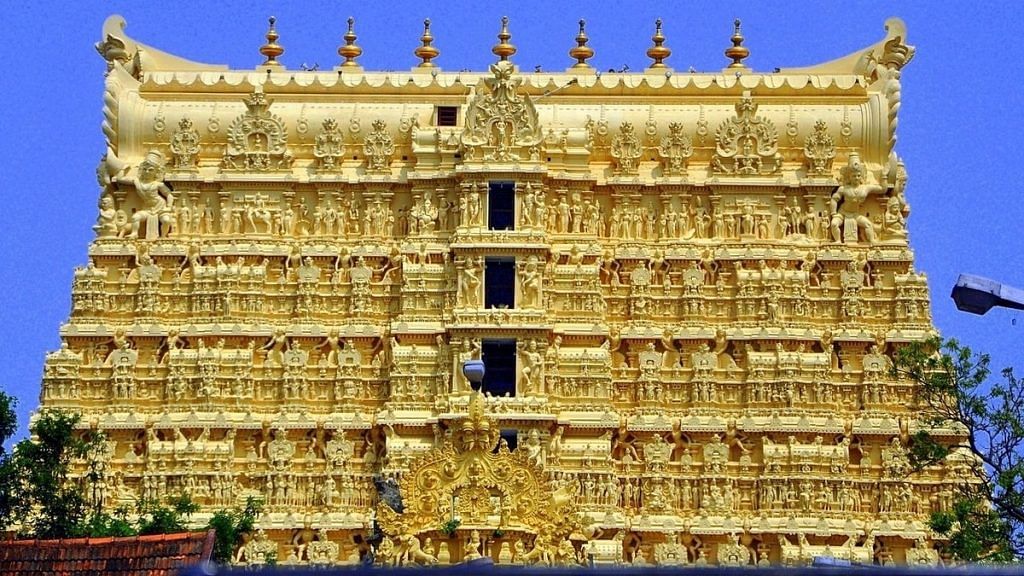Bengaluru: The Supreme Court Monday ended a nearly decade-old legal dispute, by upholding the rights of the erstwhile royal family of Travancore to manage the affairs of the Sree Padmanabhaswamy Temple in Thiruvananthapuram.
The temple has been something of an enigma, mainly because of its reputation as one of the richest in the world and the treasures it holds in its vaults.
Historians say the temple dates back to the 8th century but the present structure was built in the 18th century by the then Travancore Maharaja Marthanda Varma.
The temple is built in the unique Chera style of architecture, and its main deity is Lord Vishnu who is found in the Anantha Shayana posture (reclined posture of eternal yoga) on Adishesha or king of all serpents.
It is known to be one of the 108 holy temples associated with Vaishnavism in India.
Since independence, the temple had been controlled by a trust run by the royal family right until 1991, when the last ruler of Travancore, Chithira Thirunal Balarama Varma, passed away.
Even after the death of the last Travancore ruler in 1991, the state government allowed the management of the temple to be taken over and retained by his younger brother, Uthradam Thirunal Marthanda Varma.
But in 2011, the Kerala High Court ruled that the family cannot continue to exert its shebait rights. Shebait is a person who serves a Hindu deity and manages the temple.
That ruling has now been overturned. ThePrint explains the temple, its rulers and the treasures that made the Padmanabhaswamy Temple grab headlines.
The deity
The deity at the temple represents the trinity of Brahma, Vishnu and Shiva. Legend has it that Vilvamangalathu Swamiyar, an ascetic, traveled all over the world in search of Lord Padmanabha.
He had a vision in Thiruvananthapuram that Lord Vishnu reduced himself to 18 feet and took the reclining posture.
The royals told ThePrint that the idol is made of kadasharakara, a composition of herbs, resin and sand.
The temple was first made of wood but later constructed with granite that is seen today. It has 365 pillars, one for each day of the year.
The main idol is made with 12,500 saligram stones transported from the Gandaki river in Nepal. Saligramas are auspicious stones worshipped and venerated as the direct manifestation of Lord Vishnu.
The treasure
There are a total of six vaults located below the temple. It is the opening of these vaults to assess the contents that led to the decade-long legal battle.
In 2017, the Supreme Court appointed a seven-member panel headed by amicus curiae Gopal Subramanium to assess the value of the treasure inside the vaults, including two chambers that had not been opened for over 130 years.
When Vault A was opened by the Gopal Subramanium committee, it unearthed treasure estimated to be roughly around Rs 1,00,000 crore.
Subramanium’s voluminous report to the Supreme Court provided minute details of what was found inside the vaults — bags of gold coins from the Napoleonic, Roman, medieval and British eras. Some bags weighed close to 800 kg.
The committee also found several gold pots and chairs that were possibly used as part of religious ceremonies. A 4ftx3ft solid gold idol of Lord Vishnu studded with diamonds and precious stone and a 28-foot golden throne used to seat the deity were also found.
Apart from this, a gold ceremonial attire that may have been used on the deity, weighing close to 30 kg, was also discovered.
The committee also found sacks of gold artefacts such as coconut shelled ornaments studded with diamonds and rubies, loose precious jewels like diamonds, sapphires, emeralds and rubies along with other objects made of semi-precious metals.
Also read: Top Kerala IAS officer removed for links with woman behind UAE gold ‘smuggling ring’
The Travancore family
In 2011, Uthradom Thirunal Marthanda Varma, the younger brother of the last Travancore king, told this reporter that they belonged to one of the oldest royal families in the country.
Their family tree has been traced to 1870 AD when the Travancore dynasty was started by Ayyan Adigal Thiruvadir.
Varma said the family was intrinsically connected to the deity. “For us, life has been a full surrender to Padmanabha,” Varma had said.
“We enter the temple bare footed. We dust our feet so that not even a grain of sand from the Lord’s home should go back with us,” the royal had said. “Everything in the temple belongs to him, even a grain of sand.”
On 3 January, 1750, the family had dedicated the royal crown to the deity. By this, it declared that the deity was the Maharaja and that they were mere servants of God.
Also read: Why Kerala is planning to allow its famed plantations to grow exotic fruits
The report has been updated to correct the year the royal family dedicated the royal crown to the deity to 1750.
